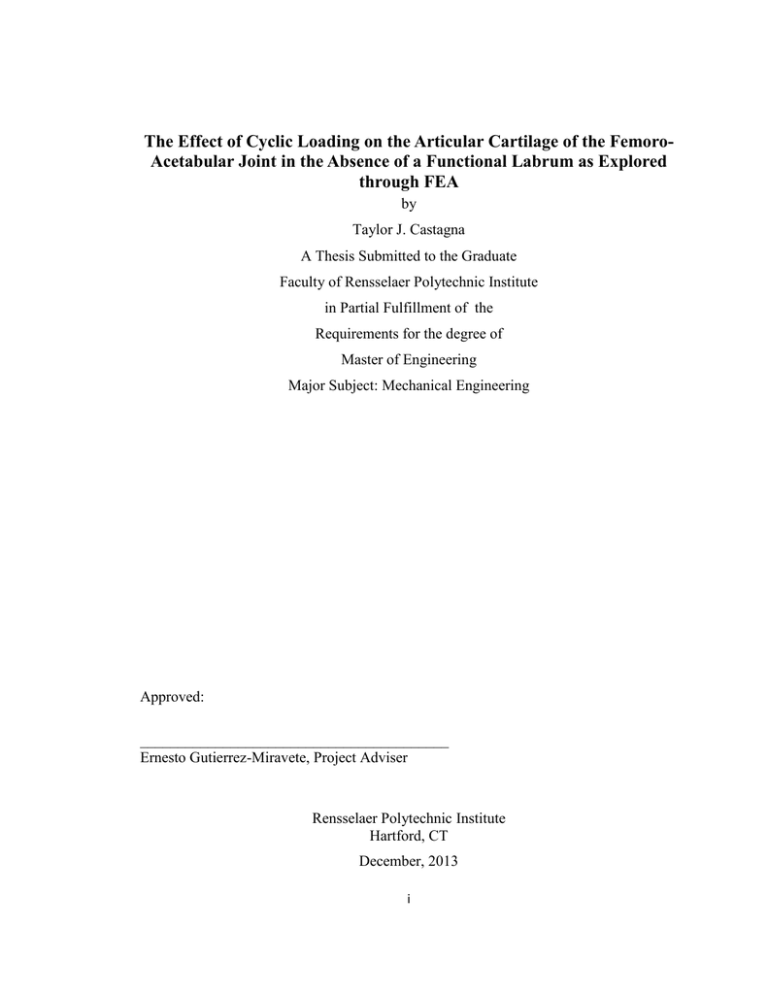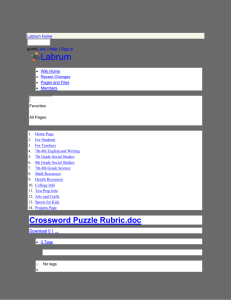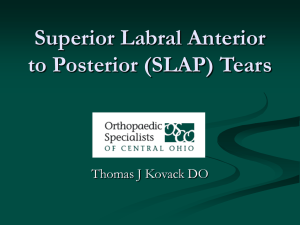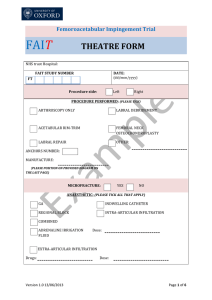The Effect of Cyclic Loading on the Articular Cartilage of... Acetabular Joint in the Absence of a Functional Labrum as...
advertisement

The Effect of Cyclic Loading on the Articular Cartilage of the FemoroAcetabular Joint in the Absence of a Functional Labrum as Explored
through FEA
by
Taylor J. Castagna
A Thesis Submitted to the Graduate
Faculty of Rensselaer Polytechnic Institute
in Partial Fulfillment of the
Requirements for the degree of
Master of Engineering
Major Subject: Mechanical Engineering
Approved:
_________________________________________
Ernesto Gutierrez-Miravete, Project Adviser
Rensselaer Polytechnic Institute
Hartford, CT
December, 2013
i
CONTENTS
LIST OF TABLES ............................................................................................................ iii
LIST OF FIGURES .......................................................................................................... iv
List of Symbols .................................................................................................................. v
Acronyms and Defintions ................................................................................................. vi
ACKNOWLEDGMENT ................................................................................................. vii
ABSTRACT ................................................................................................................... viii
1. Introduction.................................................................................................................. 1
1.1
Background ........................................................................................................ 1
1.2
Problem Description........................................................................................... 3
2. Method ......................................................................................................................... 5
2.1
Numerical Analysis ............................................................................................ 5
2.2
Modeling ............................................................................................................ 5
2.2.1
Parts and Part Geometry......................................................................... 5
ii
LIST OF TABLES
iii
LIST OF FIGURES
Figure 1: (A) Diagram of the acetabular labrum (B) View of the labral attachment points
(2) ....................................................................................................................................... 2
iv
List of Symbols
v
Acronyms and Defintions
vi
ACKNOWLEDGMENT
Type the text of your acknowledgment here.
vii
ABSTRACT
Type the text of your abstract here.
viii
1. Introduction
1.1 Background
In recent years, the management of hip and groin injuries has broadened
significantly due to advancements in arthroscopic procedures. Minimally invasive
surgical techniques allow a relatively fast recovery for athletes in highly competitive
environments or a return to normal activity without pain. The advancements in magnetic
resonance imaging (MRI) help explain the source of pain stemming from damage or
deformities interior to the femoro-acetabular joint. A major result of advanced imaging
techniques was the evaluation of acetabular labral tears. Once left untreated, the
acetabular labrum became a main focus for research due to a lack of understanding in
regard to its function.
The labrum in the human femoro-acetabular joint, located in the capsule of the
hip, is attached to the circumference of the acetabular perimeter. As shown in Figure 1,
the transverse acetabular ligament is connected to the labrum both anteriorly and
posteriorly. The labrum is thinner in the anterior inferior section and thicker, with a
slight roundness in appearance, in the posterior section. Free nerve endings have been
identified within labral tissue, which potentially explains the pain pathway in a patient
with a labral tear.(1)
1
Figure 1: (A) Diagram of the acetabular labrum (B) View of the labral attachment
points (2)
In an attempt to fully understand the pathology and study the range of surgical
techniques to remove pain associated with acetabular labrum tears, experiments and
finite element modeling have been used to explain the labrum’s function as a part of the
femoro-acetabular joint. The results demonstrate various functions of the joint, one of
the most important shown by Ferguson et al. through a finite element model is the
labrum’s function as a seal for escaping fluid under normal loading between the articular
cartilage on the femoral head and acetabulum.(3,4) The labrum effectively prevents fluid
from escaping the joint in order to retain a thin fluid film between the articulating
surfaces allowing lubrication and transfer of the load via fluid pressure, which prevents
premature wear of the cartilage surfaces by reducing cartilage consolidation. The authors
attempted to replicate the findings of the model using an in vitro experiment, with
similar results.(5) Song et al. used experimental results on cadaveric hips to show the
friction increase from partial removal or complete removal of the acetabular labrum,
further validating the hypothesized sealing function.(6)
Using magnetic resonance imaging (MRI) techniques, a patient can be diagnosed
with an acetabular labral tear and may choose to undergo surgery. In the event that the
labrum cannot be fully repaired, excision, otherwise known as debridement, which is a
2
complete or partial removal of the torn area, is implemented to relieve the pain. The
surgery may also uncover a significant amount of work or damaged articular cartilage
and may require micro-fracturing to elicit growth of new cartilage. As previously proven
by Ferguson et al., if the labrum is no longer functioning as a seal to the joint fluid,
cartilage consolidation will greatly increase. Continued rotation of the femoral head
within the joint during walking or exercising will wear away cartilage due to the
increased friction and lack of fluid to develop hydrostatic pressure to carry the load.
Therefore, a surgical technique used to re-grow cartilage may provide short-term pain
relief but the long term effects of a debrided or damaged labrum will be problematic.
1.2 Problem Description
The function of the acetabular labrum as a seal for the femoro-acetabular joint
has been widely established through finite element modeling and in vitro
experimentation. This knowledge allows refinement of surgical techniques and physical
therapy programs for patients presenting with hip pain. If a patient requires excision of
the labrum to relieve immediate pain, the long term effects on cartilage consolidation
must be considered.
A well known principle in tribology is an increase in the normal force on a
material will lead to increased frictional forces and therefore expedite wear on the
surface of the material. This project will seek to utilize the ability of finite element
software to model a material as poroelastic, in this case the biphasic (liquid and solid)
configuration of cartilage, and how exposure to different loading conditions affect the
strains and stresses in the solid matrix. The loading conditions in this case would be
normal forces into the femoro-acetabular joint from daily activities such as walking and
3
even more strenuous conditions including jogging for a prolonged period of time. The
intent is to determine if there is regimen a patient can follow after being diagnosed with
a torn labrum which will limit the wear in articular cartilage and subsequent pain.
1.3 Theoretical Background
4
2. Method
2.1 Numerical Analysis
The biphasic cartilage model detailed by Mow et al (1980) demonstrated the
mechanical properties of articular cartilage through an analytical solution. In order to
adequately analyze the joint contact mechanics within the irregular geometry of a human
joint, an appropriate finite element code is required. J.Z. Wu, W. Herzog, and M. Epstein
demonstrated the biphasic cartilage model can be implemented in the finite element code
ABAQUS. The results achieved in ABAQUS were comparable to analytical solutions as
well as other finite element codes for three numerical tests: an unconfined indentation
test, a test with the contact of a spherical cartilage surface with a rigid plate, and an axisymmetric joint contact test.
Since ABAQUS has previously demonstrated a capacity to analyze the biphasic
cartilage model proposed by Mow et al and contact mechanics, it will be used herein.
2.2 Modeling
2.2.1
Parts and Part Geometry
In the ABAQUS part module, two 2D axisymmetric parts were created to
represent the joint. The parts represent the articulating cartilage surfaces in the hip with
an intact labrum and on the head of the femur, as shown in Figure 2. A second model
was built in which the labrum was removed to represent a resected labrum. The radius of
the femur was set as 1.02” and the bone was modelled as rigid and impermeable. The
articulating cartilage surfaces were modelled to have a thickness of .11”. The joint was
modelled as being fully congruent and the labrum was modeled as being in continuity
with the articular cartilage.
5
Figure 2: Axisymmetric finite element geometry representation of the cartilage on
the femoral head (left) and the cartilage with intact labrum which is attached to the
subchondral bone of the acetabulum.
2.2.2
Property Definition
The property module in ABAQUS allows the definition of material properties
and orientations. Two materials were created for representing each the cartilage, on both
the femur and acetabulum, and the labrum.
The cartilage is modelled as a permeable elastic material with Young’s Modulus
Es=67.73 Psi, poisson’s ratio νs=0.1667, permeability k=2.89355E-009 in/s, specific
weight of the pore fluid γ=0.0361008 lb/in3, and a volume fraction for the solid tissue of
20%.
Abaqus represents the volume fraction as a void ratio (e), resulting in an initial
void ratio for the cartilage of 4 based on the following:
𝑛=
𝑉𝑣𝑜𝑖𝑑𝑠
𝑉𝑡𝑜𝑡𝑎𝑙
𝑛
𝑒0 = (1−𝑛)
(1)
(2)
The Young’s modulus and the poisson ratio were related by Lame’s first and
second constant for cartilage. In this case, for cartilage, λs=14.5 psi and µs=29 psi:
𝐸𝑠 =
µ𝑠 (3𝜆𝑠 +2µ𝑠 )
𝜆𝑠 +µ𝑠
𝜈𝑠 = 2(𝜆
𝜆𝑠
𝑠 +µ𝑠 )
6
(3)
(4)
The permeability is dependent on the strain which can be related to the void ratio
and is based on the following:
𝑒 𝜅
𝑀
1+𝑒 2
𝑘(𝑒) = 𝑘0 (𝑒 ) exp{ 2 [(1+𝑒 ) − 1]}
0
0
(5)
where k0=2.89355E-009 in/s, e is the void ratio, and e0 is the void ratio of the
undeformed state. M and κ are material constants which have been determined for
cartilage to be 4.638 and 0.0848, respectively. A tabular form imported into the abaqus
material property definition was used to define the strain dependent permeability over a
void ratio range of 1.7 to 5.
The labrum is modelled as a transversely isotropic permeable elastic material in
which the circumferential direction is out-of-plane considering the labrums unique
pathology in which fibrils run in the circumferential direction, resulting in a greater
stiffness. ABAQUS relates the stresses to the strains in each direction by the following
tensor:
where p and t stand for “in-plane” and “transverse” or out-of-plane, respectively.
In the case of poisson ratio νtp characterizes the strain in the plane of isotropy
resulting from stress normal to it, while νpt characterizes the transverse strain in the
direction normal to the plane resulting from stress in the plane. These quantities are
related by the following:
𝜈𝑡𝑝
𝜈
⁄𝐸 = 𝑝𝑡⁄𝐸
𝑡
𝑝
(6)
For the labrum, the specific engineering constants were defined as E p=80 psi,
Et=29000 psi, νp=0.05, νtp=0.05, νpt=0.0001, and Gt=3.77 psi. The shear modulus inplane, Gp, is defined by:
𝐸𝑝
𝐺𝑝 = 2(1+𝜈
𝑝)
7
(7)
where Gp=38 psi.
When engineering constants are used, a specific material orientation must be
defined. The transverse isotropy defined for the labum material is then assigned with the
orientation shown below, noting the 1 and 2 directions are in-plane while the 3rd
direction, representing the circumferential oriented fibers in the labrum, is out-of-plane:
Figure 3: Material orientation assignment for the in-plane and out-of-plane
material properties in the labrum
The permeability of the labrum was set at one-sixth of articular cartilage which is
comparable to experimental results found by (Ferguson). The strain-dependence of
labrum permeability is not well defined and since the transverse properties of the
cartilage compared with the labrum are of the same order, the strain-depenent
permeability was adapted from equation (5) and the material constants of cartilage.
However, an initial void ratio for the labrum was defined as 3, in lieu of 4 for cartilage.
2.2.3
Step Definition, Boundary Conditions, and Applied Loads
Since the articulating cartilage and labrum are modelled as poroelastic materials, a
coupled pore fluid diffusion and stress analysis was employed and a *SOILS step is
8
required. The opposing faces of cartilage are defined as contact surfaces, including the
labrum surface in the applicable model. Defining contact will allow pore fluid to flow
between the surfaces which come into contact. The degree of freedom for pore fluid flow
is 0 across surfaces as the default in ABAQUS. Since this is the case, any free surface
will employ a boundary condition which sets the pressure at this surface to zero.
Through the analysis, fluid will enter or leave this surface to maintain this boundary
condition. As previously stated, the surfaces in which the cartilage and labrum attach to
bone are made rigid and impermeable. This assumption is reasonable since the material
properties of bone are many magnitudes different compared with cartilage. The rigid
surfaces are tied to reference points on axis of symmetry. All loads and boundary
conditions are applied to these reference points since ABAQUS will define all degrees of
freedom for nodes on the rigid body by the reference node. In addition, axisymmetric
boundary conditions are applied along the axis of symmetry to prevent movement and
rotation.
9
Figure 4: ABAQUS screenshot of the interaction module (top-row) detailing the
rigid surfaces and the contact interaction surfaces. The load module is also shown
detailing the areas where pore pressure = 0 boundary condition is employed and
necessary boundary conditions for axisymmetry are shown (bottom-row).
2.2.3.1 Initial Contact Step
The first step of the analysis is used to ensure good contact between the faces due to
any differences in geometry. A small displacement of 0.002” is used on the reference
point (RP) of the femur. This boundary condition will be active in this step and then
removed in all subsequent steps for load application. A separate boundary condition is
applied and propogated to all subsequent steps to prevent left-right movement of the RP.
A simply supported boundary condition (U1=U2=0) is applied to the RP of the
acetabulum to prevent rigid body motion. For this step, a time period of 1s is used and
the steady-stade consolidation assumption is used since the transient affects of fluid flow
are not required at this point.
10
Figure 5: Initial contact step with applied displacement
2.2.3.2 Load Application Step
Once initial contact has been established, the necessary loads can be applied
2.2.4
Mesh
Figure 6 details the mesh refinement required for an accurate result. A mesh
convergence study was performed resulting in the mesh density used. CAX4P, 4-noded
axisymmetric quadrilateral, bilinear displacement, bilinear pore pressure elements were
used to handle the effective stress of a coupled pore pressure diffusion and stress
analysis. 4-noded elements were used in lieu of 8-noded since the 4-noded elements
behave better in contact. This resulted in a much denser mesh due to half the number of
nodes used for each element.
11
Figure 6: Mesh of CAX4P elements for both the intact labrum and resected labrum
12




